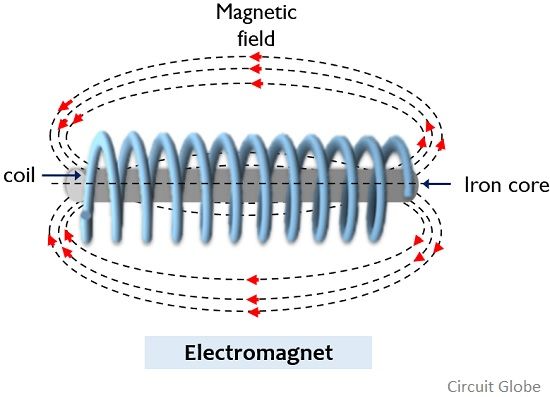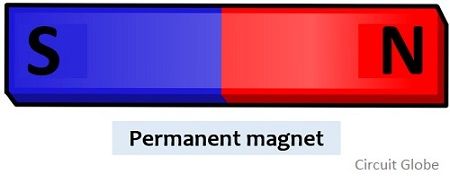Electromagnets and permanent magnets are the two major types of materials that exhibit magnetic properties. However, the two are majorly differentiated on the basis of the generation of the magnetic field. So, the difference between an electromagnet and a permanent magnet is that an electromagnet generates a magnetic field when an electric current is provided to it. As against, a permanent magnet produces a magnetic field on its own when it is magnetized.
What is a magnet?
So, a material that possesses magnetism is known as a magnet. A magnet generates a magnetic field which represents the magnetic force existing within and the region around the magnet. The magnetic field is vector in nature and its strength is determined by the density of the field lines. This is because of the bunching of the field line. The similar poles of magnets repel each other while the different poles of the magnet attract each other.
There are various other parameters that distinguish electromagnet from the permanent magnet, which we will discuss here.
Content: Electromagnet Vs Permanent Magnet
Comparison Chart
| Basis for Comparison | Electromagnet | Permanent Magnet |
|---|---|---|
| Generation of magnetic field | Due to electric current | Due to material characteristics when magnetized. |
| Strength of magnetic field | The strength of field depends on the total current flowing through the solenoid or coil. | Here the magnetic field strength solely relies on the respective material. |
| Magnetization | Temporary | Permanent |
| Type of material used | Generally soft iron core | Usually it makes use of hard material. |
| Demagnetization | It is demagnetized when flow of current is stopped. | The material is demagnetized when it is subjected to extremely high temperature. |
| Requirement of external power | Exist | Not Exist |
| Magnetic field retention | Field is retained till the time current flows though the material | These materials retain the field all the time. |
| Cost | Low | Comparatively high |
| Poles of the magnet | Can be varied. | Here the poles can never be changed. |
| Example | A solenoid across an iron | Bar Magnet |
| Applications | Electric bells, loudspeaker, motors, etc. | Cell phones, headphones, sensors, etc. |
Definition of Electromagnet
Electromagnets are the material that produces a magnetic field as a result of the flow of electric current. These are formed by winding a conductive wire around a soft metallic core. Basically, when excitation is provided to the wire by a source, then electric current flows through the wire. This leads to the creation of a magnetic field around the coil, thus causing the metal to get magnetized.
The magnetic field produced by electromagnets is of temporary nature as the generation of the magnetic field depends on the flow of current. Thus, with the removal of the current, the magnetic field also diminishes. So, we can say that the strength of these magnets varies with the amount of current flowing through the coil.
Thus, sometimes these are referred as controllable magnets.
Electromagnets have different north and south pole which depends on the direction of the flow of current. The magnetic field in an electromagnet is the result of current flowing in two adjacent conductors. Hence, the direction of flow of current sets up the magnetic field. The force between two conductors is the outcome of the interaction between the two fields.
Definition of Permanent magnet
A permanent magnet is a hard-magnetic material which is magnetized at the time of manufacturing thus has its own magnetic field. These do not need external power as their magnetic properties are independent of any external excitation.
The various types of permanent magnets are:
- Alcino
- Neodymium
- Ferrite
- Samarium Cobalt
Now, the question arises, how permanent magnets have their own magnetic field?
So, basically, the ferromagnetic material has a weak magnetic field which is generated by the electrons surrounding the atomic nuclei. Such a group of atoms forms magnetic domains. To create a permanent magnet from a ferromagnetic material, the ferromagnetic material is provided an extremely high temperature in the presence of a strong external magnetic field.
This leads to lining up the magnetic domains in the direction of the external magnetic field. Once the material obtains its magnetic saturation then it is cooled while the domains remain fixed in their aligned position. This creates a strong permanent magnet.
Magnetization to the materials is provided to align the domains that are present in random directions. This is so because in random directions the magnetic fields of the domains cancel each other. Thus, once the permanent magnets are magnetized then these hold their magnetic property for a very long time.
However, the demagnetization of permanent magnets is generally done by exposing the magnet to a very high temperature. As this causes the spreading of aligned domains again.
Key Differences Between Electromagnet and Permanent Magnet
- An electromagnet offers temporary magnetization while a permanent magnet exhibits permanent magnetization for a considerable amount of time.
- The magnetic field of the electromagnets depends on the current flowing through the material. However, in the case of permanent magnets, the magnetic field exists in the material once magnetized.
- As electromagnetic materials require a continuous flow of current thus regular supply of electric power is necessary in the case of electromagnets. While this is not the case with permanent magnets.
- Generally, whenever there arises the need for demagnetizing the magnet then electromagnets are demagnetized simply by removing the flow of current through the material. While excess high temperature is required to provide in order to demagnetize, the permanent magnet.
- For an electromagnet, the strength of the magnetic field changes according to the amount of current flowing through the material. However, although a permanent magnet holds the magnetic field permanently for a very long duration if the magnetic property gets lost then the material is useless.
- A solenoid winding across an iron core is an example of the electromagnet, whereas, for a permanent magnet, the bar magnet is an example.
- The initial cost of an electromagnet is low but it requires a continuous source of energy to produce a magnetic field. As against permanent magnets are comparatively costlier than electromagnets but does not require an external power supply.
- As electromagnets need copper coupling thus needs larger space while permanent magnets have a comparatively compact structure.
- The polarity of electromagnets depends on the direction of the flow of current thus it can be varied. However, the polarity in the case of permanent magnets is fixed and cannot be changed.
Conclusion
Therefore, this discussion concludes that the magnetic field of the electromagnet depends on current thus is temporary in nature. While the field of the permanent magnet is permanent once magnetized.


